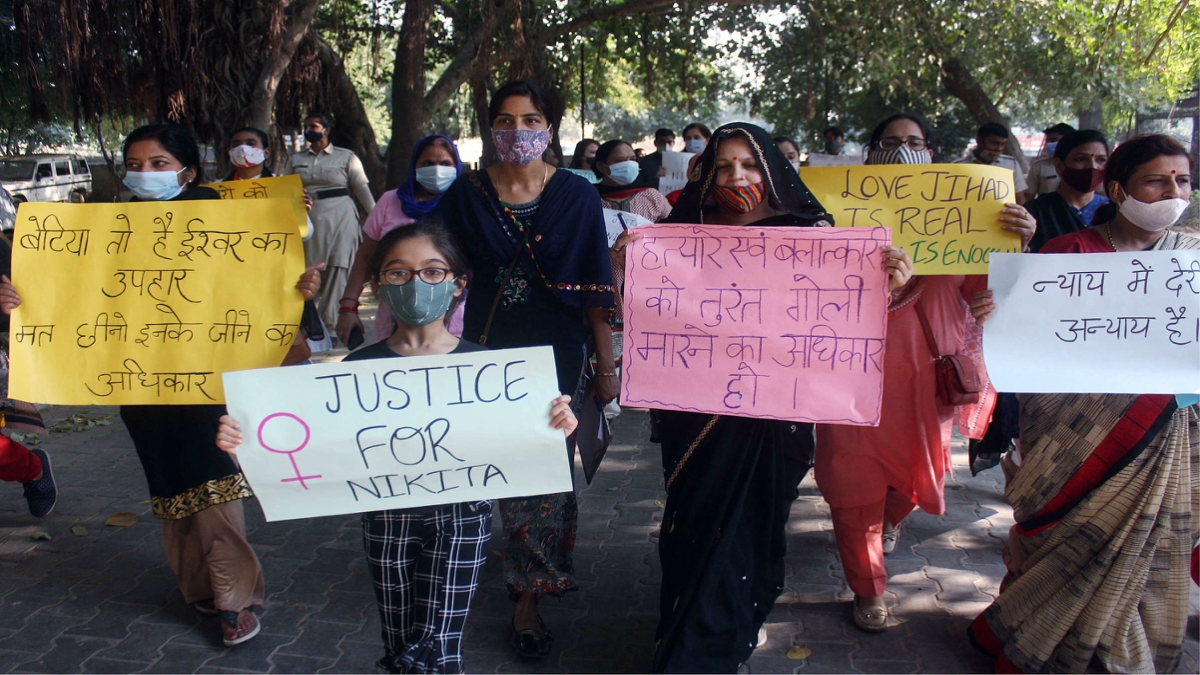


Last week, a young woman was shot dead in the Ballabhgarh area of Faridabad district, which falls in the National Capital Region (NCR), for a simple refusal which had been unacceptable to an enfranchised man. The perpetrator belongs to a family with political clout. About 100 km away, Hathras of Uttar Pradesh, known as the birthplace of Gautam Buddha’s mother, Mahamaya, and of satirist Kaka Hathrasi, came under the national limelight recently after the alleged rape and murder of a Dalit girl. Such violent crimes against women get justified shamelessly thanks to structural notions about gendered roles and relations. Both these cases have also been dissected from the angles of gender, caste, class and religion, besides legal and political perspectives. There is a need now to refocus the lens on the security of women.
The disdain for women’s rights is not surprising in a country where legislators who should be accountable for framing policies for women’s empowerment are accused of crimes against women. All national and regional political parties have fielded candidates or have sitting legislators accused of crimes against women.
As per an Association of Democratic Reforms (ADR) report, between 2009 and 2019, there was a 231 percent increase in the number of contesting candidates and an 850 percent increase in the number of Lok Sabha MPs with declared cases of crime against women. None of them was convicted though. From such powerful men, who can obliterate and manipulate the rule of law, interfere with police investigations, and eventually compromise the courts’ ability to deliver justice, it is unreasonable to expect any concern for women’s issues, particularly with regard to their security.
In 2017, the Bhartiya Janata Party (BJP) had won 325 out of 403 seats in Uttar Pradesh, way beyond the halfway mark. Soon after winning India’s most populous state, it had declared: “Implementation over mere lip-service—BJP has given maximum number of women MLAs in 17th UP Assembly, highest since independence”.
There had been a marginal improvement in the Assembly polls too, from 8% (32 out of 403 MLAs) in 2012 to 10% (40 out of 402 MLAs) in 2017. But it is noteworthy that 31 out of these 40 MLAs, i.e., nearly 75%, are ‘crorepatis’.
The 2017 Assembly election was perhaps not an aberration. The 2019 general elections marked a paradigm shift in terms of women’s representation in the legislature. With 78 women MPs from across the country, women’s representation in the Lok Sabha improved to 14 percent from 11.3 percent in 2014. The improved representation notwithstanding, the diversity of this cohort leaves much to be desired. So far, only women from political or financially sound families and those belonging to the fields of entertainment and sports have been able to sustain themselves in Delhi’s political panchayat. Others who stray into the arena are disparaged as ‘item girls’.
A March 2019 ADR report shows that about 85 percent of women MPs in both the upper and lower houses of the Parliament are ‘crorepatis’. More than 75 percent of women parliamentarians of the BJP and the Congress were ‘crorepatis’. In some regional parties, almost all women legislators were ‘crorepatis’. A Lokniti-KAS study too suggests that the socio-economic status determines women’s participation in elections, with women from the upper castes and wealthier backgrounds being more active. Moreover, the pathway to women’s political participation is also impeded by patriarchal culture.
Government schemes such as the Swachh Bharat Mission, Ujjwala Yojna, financial inclusion programmes such as Beti Bachao, PM Jan Dhan Yojana, Sukanya Samridhi Yojana and Pradhan Mantri Mudra Yojana include the emancipation of women as one of their goals. This approach has limited efficacy as women’s issues are tied to other agendas. Building toilets doesn’t ensure sanitation, providing gas cylinders doesn’t ensure health, providing cycles won’t ensure accessibility – not until a woman feels tied down in her laaj and sharam, not secure enough to step outside her dahleez. Until then, achchhe din is a long time coming for women in India.
Women’s security, education, health and livelihood feature routinely in political discourses. However, it is difficult to prepare an environment conducive to women’s fearless political participation without systemic reforms. Unfortunately, none of the Indian political parties have addressed the challenge regarding the lack of women in leadership positions. The process of ticket distribution is also intrinsically linked to winnability instruments such as caste and religion, and not with women’s issues.
More women in leadership will transform policymaking by making it more inclusive. However, as per a January 2020 report by Inter-Parliamentary Union-UN Women, India was placed 134 on the index for women in ministerial positions and 142 for women in Parliament. In the absence of reservation, an enabling environment will remain a distant possibility. Indeed, countries with high women’s representation in legislature have enshrined it in a reservation system. It has been ten years since the Women’s Reservation Bill was cleared by the Rajya Sabha in March 2010 but, despite multiple reintroductions, it is still pending in the Lok Sabha. The impending bill seeks to reserve one-third of all seats for women in the Lok Sabha and the state legislative assemblies.
Only time will tell if tragedies such as the Ballabhgarh and Hathras cases will be an issue during the Assembly and general elections. Parties need to move beyond manifesto bullet points and symbolic roles to women as spokespersons and create safer spaces within their structures for women to become visible in the electoral scene. Along with the parties, the Election Commission of India (ECI), election funders, including private organisations and corporates, too, need to step up and support free political participation by women.
The writer is a public policy consultant and analyst. She comments on politics and international affairs of India.